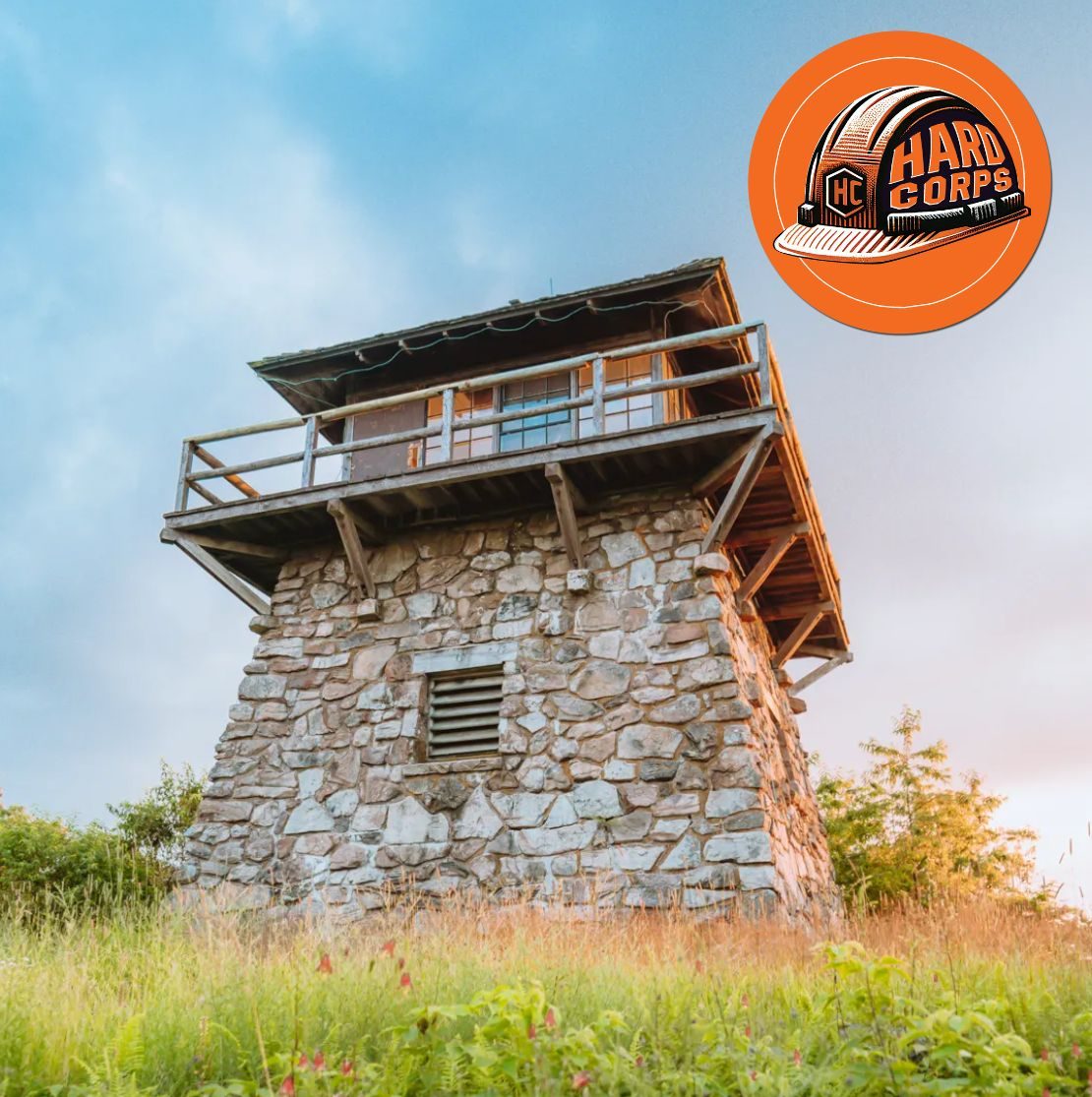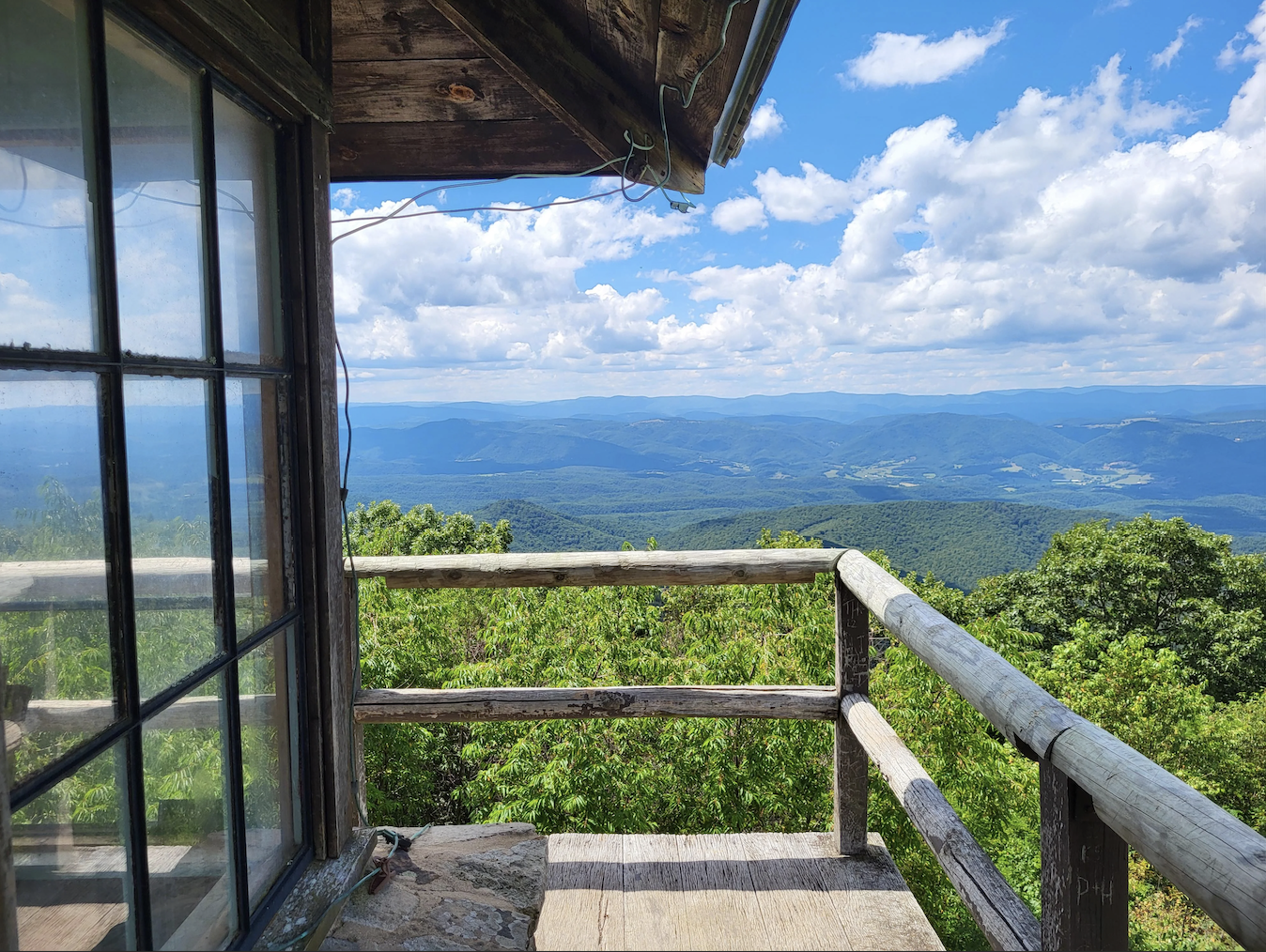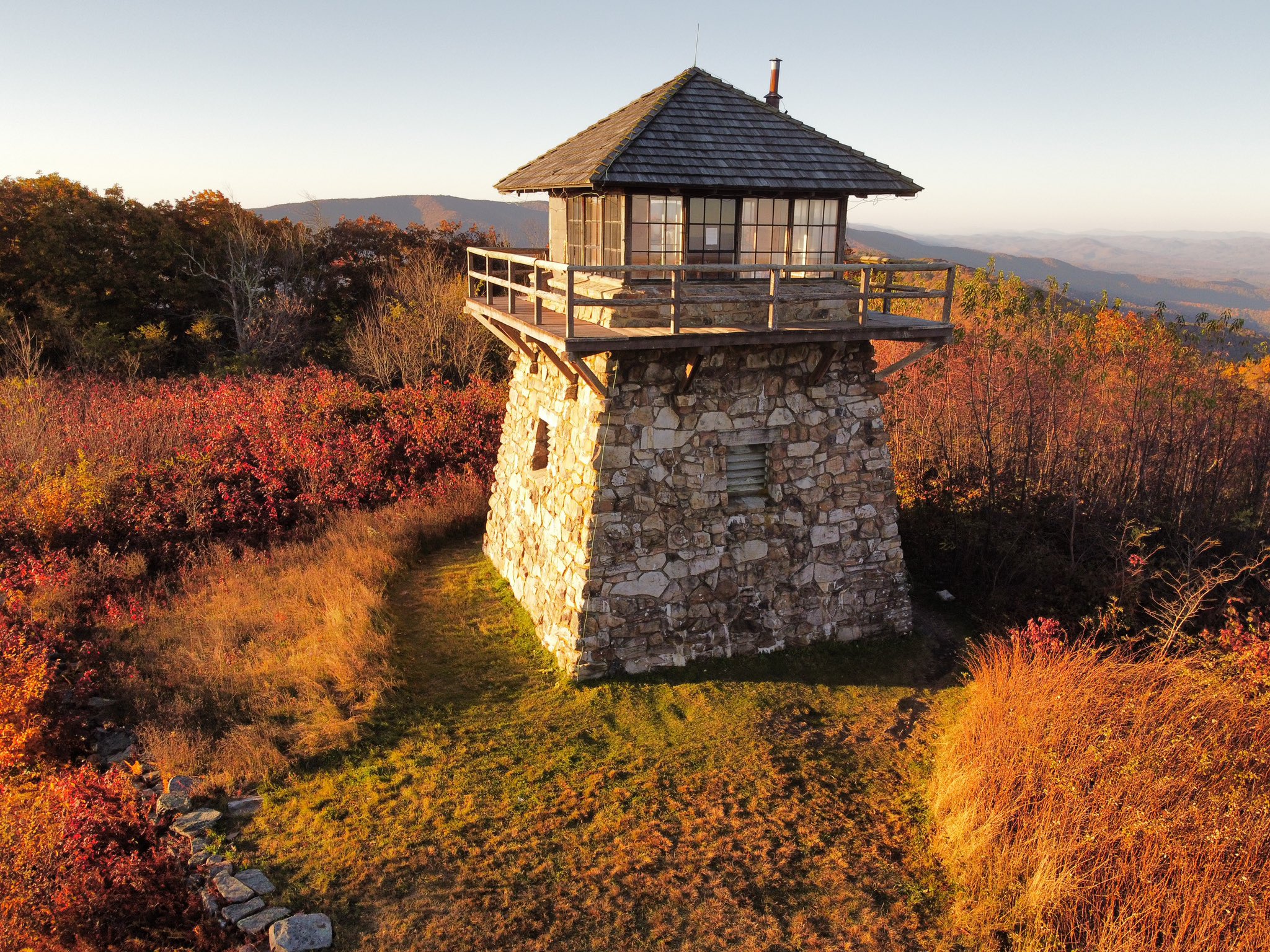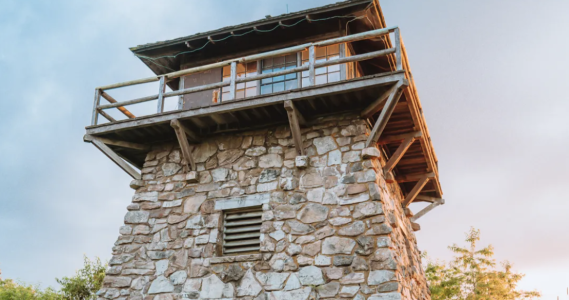High Knob Fire Tower, WV 2024

Atop the rugged hills of West Virginia is the High Knob Fire Tower, the only stone constructed fire tower east of the Mississippi.
PROJECT PARTNER: George Washington and Jefferson National Forests
SESSION DATES: June 9-14
PROJECT SUPERVISOR: Pete Specht!
CREW LEADER: Karina Burbank!
*This is a HardCorps project which will involve a higher degree of difficulty for participants*
Project Site Description & History
Rising atop the crest of Shenandoah Mountain is the High Knob Fire Tower, a one of kind stone-constructed lookout tower built in the 1930s that symbolizes a pivotal era of forestry management and labor force cooperation. Formerly the Shenandoah National Forest from 1917-1932, the now George Washington and Jefferson National Forests has been a pioneer in forest fire prevention, establishing an early precedent for the era to prevent, detect, and suppress wildfires.
During the 1930s, fully metal fire towers were being erected as the forest shifted policy to counteract the damaging effects of forest fires. In 1939, construction began on the High Knob Fire Tower which sits directly on the border line of Virginia and West Virginia, rising just over 4,000 feet above sea level. As with many labor projects sprouting during the 1930s, President Theodore Roosevelt’s New Deal was keen to put out of work men to use, and the forest engaged post-war Veterans of World War I as a labor force while also partnering with the local Civilian Conservation Corps Camp #2 of North River to build the stone fire tower.
By the late 1960s the forest began rethinking their fire prevention systems and would ultimately conclude their towers to be an ineffective resource, ordering their widespread removal and decommissioning rangers as they shifted to a modern aerial fire detection approach by 1972. HistoriCorps is excited to engage volunteers on our first “HardCorps” project as we get set to restore High Knob Fire Tower. For more in-depth information about the history of the fire tower and those who operated it, please visit Friends of Shenandoah Mountain’s website.



Location and Logistics
SESSION DATES: June 2-7 and June 9-14
Please plan to arrive at the campsite no earlier than 5pm and no later than 7pm on the first day of your session.
LOCATION: Located on the Virginia and West Virginia borderline 22 miles Northwest of Harrisonburg, VA.
ACCESS: ![]()
![]()
![]()
![]()
![]()
![]()

![]()
Tents, truck and car campers, campervans, trailers, and RVs 25 feet and under will have access to our campsite. Hookups are not available, dogs are allowed, and showers will be available at our campsite. There is a small lake at our campsite which would be great for kayaking after work!
WEATHER: Anticipate highs in the 70s and lows in the 50s. Weather conditions may be rainy, cloudy, or sunny. Volunteers are responsible for checking weather conditions before their session begins, and packing appropriately.
ABOUT VOLUNTEERING: HistoriCorps projects are free for volunteers! HistoriCorps will provide all meals, tools, training, equipment, and a campsite. Volunteers are responsible for their own transportation to the campsite, sleeping equipment, work gloves, clothes and boots, and other personal gear.
Scope of Work
SCOPE OF WORK DIFFICULTY: ![]()
HistoriCorps is committed to educating and training volunteers in preservation skills, with an overarching mission of inspiring a preservation ethic in all those involved. Learning and working alongside expert HistoriCorps field staff, volunteers and applying the traditional skills necessary to restore the High Knob Fire Tower:
- Selectively pull up cat walk decking for assessment
- Re-glazing and repairing all windows surrounding observation room
- Minor carpentry repairs
*HardCorps Details – Please Be Prepared Before Registering For This Project*
- Volunteers will work from an unstable staircase and catwalk utilizing fall protection systems
- Due to the position of the fire tower on top of the ridge along with the unstable conditions of the tower, volunteers will experience significant exposure to heights
- There will be no bathroom at the fire tower, but volunteers will have access to a temporary camping toilet during the work day
Please note: Tasks vary by day and by week, depending on a variety of factors including: weather, project priorities, previous groups’ work, and more. Though it is likely you will get to learn and practice most or all of the above tasks, it is not guaranteed. The higher percentage of the scope a particular task is, the more likely you will get to practice it.
Sign Up!
We’re thrilled this project has inspired you to volunteer!
CLICK HERE TO REGISTER!
Visit our Job Calendar to see spaces are available!
*All registrations submitted to projects at capacity will be automatically added to our waitlist.*
CANCELLATIONS effect our ability to complete projects. Please register only if you are certain about your ability to participate.
You will know your registration was successful when you receive a confirmation email. Contact volunteer@historicorps.org for assistance.
HistoriCorps does not charge for its volunteering projects. HistoriCorps relies on donations to continue engaging volunteers to save significant historical sites across America for generations to come. Your donation of any amount will make an incredible difference! Increase your impact – make a generous gift today.
Volunteer Logistics, Policies, and Advice
We’re so glad you’re interested in joining this project! If you’re new to our community, review the Volunteer FAQ first! Please note the following logistics and policies:
- Volunteering with HistoriCorps is free! We will provide all meals, tools, training, equipment, and a campsite or shared indoor lodging. Dinner is not provided on the first night.
- Volunteers are responsible for bringing their own gear, work gloves, sturdy work clothes and boots, and appropriate sleeping equipment. Check the average temperatures before you start packing – the nights and mornings may be colder than you anticipate! Then, read this advice about how to stay warm when tent camping in colder places.
- Campsite accessibility varies by project. Some projects can accommodate tents only; others can accommodate small RVs. Please review the project site description above for more information, and if you’re still not sure, email volunteer@historicorps.org for help.
- If this project does not offer showers, you might want to consider bringing a solar shower or research other methods to clean up after the work day.
- Volunteer crew sizes generally range from 4-8 volunteers, with two HistoriCorps staff that lead and train volunteers in the work.
- Safety is one of HistoriCorps’ top priorities, and volunteers can contribute to a safe working environment by ensuring their physical fitness is adequate for the work. See above for this project’s scope of work and difficulty level. Please, call us if you are not quite sure if a project is a good fit for your skills or fitness level. We may be able to suggest a project more suitable and enjoyable for you.
- Hard hats, eye protection, ear protection, gloves are standard personal protection equipment (PPE) required on all projects. Hard hats must be worn at all times on the project site, unless working in a designated safe space. Field staff will train volunteers on correct use of PPE.
- Dogs are generally allowed to accompany their humans in project campsites (actually, we love having dogs join us around the campfire!). Dogs are not permitted on the job site for everyone's safety. HOWEVER: HistoriCorps also follows the rules and regulations of our project partner. If the project partner does not permit dogs onsite then HistoriCorps is no exception. Please ask HistoriCorps or the project partner directly if you have any questions about whether Fido is welcome.


